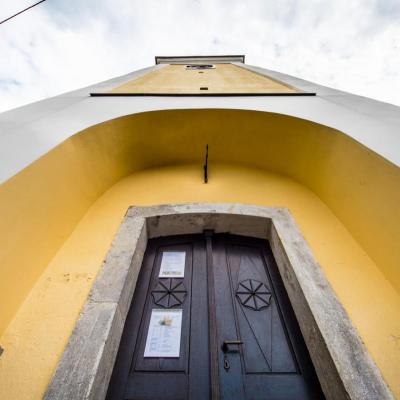
Churches in the area of Dolenjske Toplice
PARISH CHURCH OF ST. ANDREW THE APOSTLE IN KOČEVJE POLJANE
The parish church, located on the edge of the village, positioned on a hill above the rectory, was built in 1625, during the Baroque period, and its interior is decoratively painted. It boasts several pieces of selected and quality interior equipment. The main attraction is undoubtedly the main altar from 1757, the work of an unknown author. It is a beautiful late Baroque setting surrounding the central niche with the statue of the patron saint of the parish, St. Andrew. In the attic of the altar, there is an oval painting of Archangel Michael, attributed to Valentin Metzinger, although it is said to have been heavily repainted later. The altar also features statues of St. Anne and St. Joachim, which used to stand independently on consoles next to the altar.
Among the church furnishings, it is worth mentioning an interesting Stations of the Cross, painted on metal (a copy of Führich’s work) with inscriptions in German Gothic script, which is certainly a poignant memory of the former inhabitants and the organ. In 1861, they were made by the master Franc Dev and are considered very valuable by experts, as they are among his rare preserved works. The organ case is a beautiful Baroque piece. Another interesting part of the furnishings is the restored stained glass windows with oval images of saints. The windows also have German inscriptions.
PARISH CHURCH OF ST. ANNE, DOLENJSKE TOPLICE
Location: Zdraviliški trg 8, 8350 Dolenjske Toplice. The parish of Toplice initially fell under the parish of Novo mesto – Šmihel. In 1481, it became a vicariate, and in 1770, it became a parish. The parish church is first mentioned in a document in 1334. Initially, it was called the Church of Mother of God in Toplice near Rožek, but later it was dedicated to St. Anne. The current building retains remnants of its predecessor, a medieval church from the late 15th century. This is particularly noticeable in the presbytery, which has a characteristic floor plan with blocked Gothic windows, and its remnants also include a Gothic portal on the choir loft. During the Turkish threat, this medieval Gothic church was surrounded by walls. One tower with embrasures and part of the defensive wall on the south side of the church have been preserved. The current church was built or extensively renovated in 1656. The plan for it was most likely made by the then-priest Matija Kastelic, who was also an architect and a well-known religious writer. His memory is preserved in the inscription on the baptismal stone from 1648 MK, which is the oldest preserved part of the church furnishings.
The author of the main altar is unknown, but it was created in the second half of the 18th century, in 1786. It is a fine example of late, subdued Baroque style. The main part of the altar is occupied by a throne, a niche with a gilded frame containing the statue of St. Anne. Next to it are statues of St. Joachim, Peter, Joseph, and Paul. Above the rather prominent and centrally interrupted section of the altar is a very rich and elaborate group of the Coronation of Mary under a canopy in the attic. The church also has beautiful stained glass windows, the work of Ivan Pengov.
PARISH CHURCH OF ST. ERASMUS IN SOTESKA
Location: Soteska 18, 8351 Straža pri Novem mestu
The parish in Soteska was established in 1617, and the current church was built between 1680 and 1690. The original church is said to have stood here before 1400 when the first resident priest is mentioned. Its builders and patrons (custodians) were the lords of Soteska, who equipped it according to their status.
The former main wooden altar was unfortunately destroyed, and today, the altar’s backdrop is painted on the wall, with a painting of St. Erasmus hanging in the center. The coffered ceiling in the presbytery was richly painted. Even this painting (by Goldenstein) is now destroyed. However, both altars in the side chapels remain. Both are beautiful examples of the Baroque style. The southern one is dedicated to the Death of the Lord on Calvary (below which is the tomb), and the right one is dedicated to St. Cecilia, the sister of St. Erasmus. Her painting is said to be the work of Cebej.
On the arch in the presbytery, the tombstone of Ivan Adam Gallenberg is built into the inner side, while on the outer side, there is the coat of arms of the Gallenberg family. The church also houses the castle tomb.
